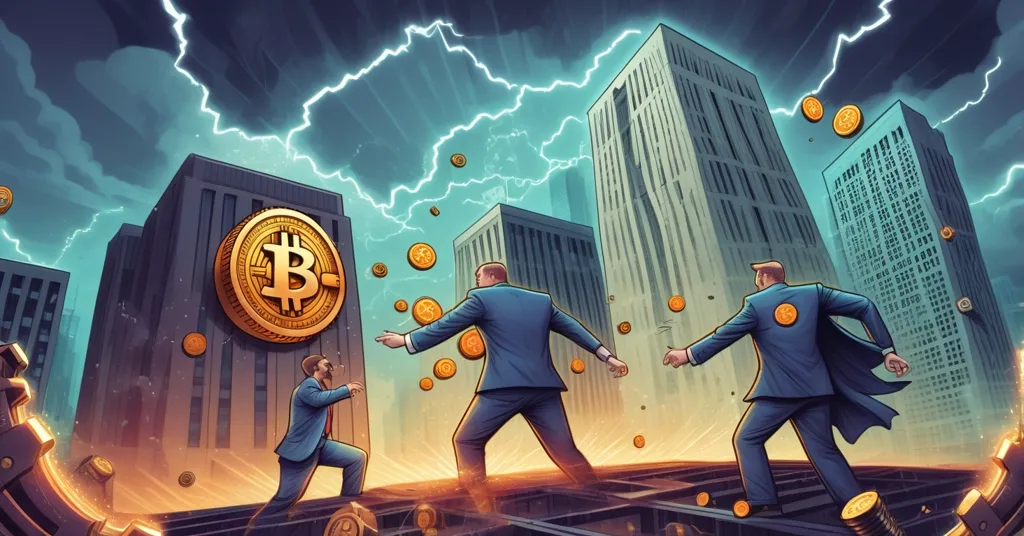Fed Rate Cut Pressure Mounts: How Bitcoin and Crypto Could Surge or Stumble

Federal Reserve Under Fire: Rate Cuts Urged as Economy Falters—What’s at Stake for Bitcoin and Crypto?
Treasury Secretary Scott Bessent has fired a warning shot at the Federal Reserve, demanding faster interest rate cuts as inflation cools and key sectors like housing grind to a halt. This isn’t just a Wall Street squabble—it’s a pivotal moment that could shape the trajectory of risk assets like Bitcoin and the broader cryptocurrency market, potentially igniting the next bull run or leaving investors in the lurch.
- Inflation Easing: Consumer prices up only 3% year-over-year in September, near the Fed’s 2% target.
- Housing Collapse: High mortgage rates cripple first-time buyers, risking broader economic fallout.
- Crypto Impact: Rate cuts could flood liquidity into Bitcoin and altcoins, while delays might stall momentum.
The Fed’s Tightrope: Rate Cuts or Recession?
Bessent pulled no punches on CNN’s State of the Union, slamming the Federal Reserve for clinging to high interest rates long after inflation has started to tame. With consumer prices rising at just 3% in September—the slowest pace in over two years and barely above the Fed’s 2% sweet spot—he argues that the central bank’s iron grip is now a bigger threat to the economy than price surges ever were. For context, interest rates set by the Fed determine borrowing costs across the board, from mortgages to business loans. High rates choke spending and investment, while low rates act like rocket fuel, spurring economic activity—and often speculative markets like crypto. If you’re curious about Bessent’s full critique, check out his recent comments on the Fed’s policy stance here.
Despite the cooling inflation, the Fed remains in a bureaucratic bubble, refusing to budge until “disinflation”—a slowdown in the rate of price increases, not to be confused with prices dropping—proves rock-solid. This hesitation is drawing flak from all corners, including dissenting Fed officials, economists, and market players who see the data screaming for relief. Bessent’s frustration isn’t abstract; it’s rooted in real pain points, particularly in sectors already on life support. If the Fed keeps playing monetary hardball, we’re not just looking at a policy misstep—we’re staring down the barrel of a broader slowdown.
“Keeping interest rates high was now doing more harm than good.” – Scott Bessent, U.S. Treasury Secretary, on CNN’s State of the Union
Housing Crisis: Dominoes Ready to Fall
Nowhere is the damage more evident than in the housing market, which Bessent bluntly calls a “recession” in its own right. Skyrocketing mortgage rates—tied directly to the Fed’s benchmark—have frozen home sales, with first-time buyers and low-income households bearing the brunt. These folks often juggle more debt than assets, and getting locked out of homeownership isn’t just a personal setback; it’s a systemic gut punch. The National Association of Realtors reported pending home sales flatlined in September, a stark signal of stagnation.
The ripple effects are ugly. Housing doesn’t exist in a vacuum—it’s tied to construction, a massive job generator, and retail, as consumer spending takes a nosedive when folks can’t move or renovate. Bessent warns that sustained high rates could turn this sector-specific slump into a full-blown economic drag, and market indicators aren’t exactly reassuring. Two-year Treasury bond yields have slipped below the Fed’s rate—a phenomenon known as an inverted yield curve. Think of it as a weather forecast for a storm: when yields flip like this, markets are betting on trouble ahead, often a recession. Historically, this signal has been eerily accurate, and right now, it’s flashing red.
Adding to the chorus for cuts, the CME FedWatch Tool—a gauge of market sentiment—shows a 70% probability of a rate reduction by early 2026, up sharply from 45% a month ago. Investors aren’t just hoping for relief; they’re banking on it. Yet, the Fed’s top brass seems content to play chess while the economy stumbles through checkers, delaying action until every last inflation ghost is busted.
Internal Dissent and Labor Market Jitters
Even within the Fed, cracks are showing. Governor Stephen Miran recently pushed for a hefty 50-basis-point cut—think of basis points as percentage slivers, so 50 is half a percent—only to be outvoted for a measly 25-basis-point trim. Meanwhile, Governor Christopher Waller has been banging the drum for a December cut, pointing to softening job growth as the real boogeyman, not inflation. Labor market weakness matters because when unemployment ticks up or wages stagnate, disposable income for investments—yes, including crypto—dries up, especially for retail players who drive much of the market’s volume.
“The biggest concern we have right now is the labor market. We know inflation is going to come back down, so this is why I’m still advocating that we cut policy rates in December, because that’s what all the data is telling me to do.” – Fed Governor Christopher Waller, on Fox Business Network
On the fiscal side, there’s a faint glimmer of hope. The U.S. deficit-to-GDP ratio dropped from 6.4% to 5.9% thanks to spending cuts under the Trump administration, easing some pressure on government borrowing that could otherwise stoke inflation. Less borrowing means less need to print money, which indirectly bolsters Bitcoin’s narrative as a hedge against currency debasement. But fiscal discipline doesn’t fix the Fed’s monetary stranglehold, and Bessent’s camp sees every delay as a step closer to economic quicksand.
Crypto’s Stake: Bull Run or Bear Trap?
So, why should Bitcoin enthusiasts care about this Beltway drama? Simple: Federal Reserve policy is a linchpin for risk assets, and cryptocurrencies are the wildest of the bunch. High interest rates mean expensive borrowing, pushing investors toward “safe” havens like bonds over speculative plays like Bitcoin or Ethereum. Slash those rates, though, and cheap money floods the system, often igniting a frenzy for high-risk, high-reward bets. We’ve seen this play out before—post-2008 quantitative easing (where central banks pumped cash into the economy by buying assets) and 2020’s pandemic-era rate cuts sent Bitcoin soaring from $9,000 to nearly $29,000 by year-end. If Bessent’s push for faster cuts gains traction, history suggests we could see a similar tailwind, driving both prices and adoption.
Let’s get specific with Bitcoin. As the original crypto and a perceived store of value—often dubbed “digital gold”—it tends to shine when traditional finance looks shaky or liquidity abounds. During the 2020 low-rate environment, institutional interest spiked, with firms like MicroStrategy stacking sats (Bitcoin units) as a treasury reserve. A fresh round of rate cuts could reignite that fervor, especially as inflation fears linger despite the cooldown. For our Bitcoin maximalist lens, this is where the real action is: BTC doesn’t need the Fed’s permission to disrupt centralized systems—rate games just amplify its allure.
Altcoins, though? They’re a mixed bag. Ethereum, with its smart contract platform powering decentralized finance (DeFi—think financial apps without banks), and Solana, focused on high-speed transactions, fill niches Bitcoin doesn’t touch. Lower rates could pump their prices short-term as speculators pile in, but many altcoins are hype-driven rollercoasters even thrill-seekers might avoid. Without Bitcoin’s battle-tested fundamentals, they’re more vulnerable to macro whiplash. I’ll tip my hat to their innovation, but I’m not betting my stack on their staying power.
Playing Devil’s Advocate: Fed Caution Isn’t Baseless
Now, let’s flip the script. The Fed’s dithering—while infuriating—has some logic. Inflation at 3% is tame compared to post-pandemic peaks, but it’s not buried. A premature rate cut could spark a resurgence, especially if geopolitical flare-ups (think oil price spikes) or supply chain snarls hit again. Back in 2022, energy and food shocks drove inflation to 9%; underestimating those risks now could be catastrophic. For crypto, renewed inflation might boost Bitcoin as an anti-fiat hedge, but altcoins tied to speculative fluff could get obliterated if economic stability unravels.
Then there’s the regulatory wildcard. Even if rates drop and liquidity surges, the U.S. government isn’t exactly a crypto cheerleader. The SEC’s ongoing tug-of-war over Ethereum ETFs and murmurs of harsher tax rules on digital assets could kneecap market gains. Liquidity helps, but it doesn’t override a hostile policy environment. And let’s not ignore labor market fragility—recent unemployment ticks (hovering near 4.1% in late 2023 data) mean less spare cash for retail investors to YOLO into crypto. Rate cuts might ease the pain, but they’re not a magic wand.
Bitcoin vs. Altcoins: Who Wins in a Low-Rate World?
If we strip away the noise, Bitcoin stands tallest in a low-rate scenario. Its fixed supply and decentralized ethos make it the ultimate middle finger to centralized monetary games—whether the Fed cuts or stalls, BTC’s core promise of financial sovereignty holds. Altcoins might snag short-term pumps, but their reliance on hype and unproven use cases leaves them exposed. Ethereum’s DeFi ecosystem is legit, sure, but how many “next big thing” tokens have crashed and burned? Rate-driven rallies lift all boats, but Bitcoin’s the yacht that won’t sink when the storm hits.
For newcomers, a quick primer: Bitcoin operates on a blockchain, a decentralized ledger recording transactions without a central authority. Its scarcity—capped at 21 million coins—makes it a potential shield against inflation, unlike fiat currencies the Fed can print endlessly. Altcoins often build on this tech with bells and whistles (smart contracts, faster payments), but many lack Bitcoin’s resilience or network security. When macro winds shift, that distinction matters.
What’s Next for Crypto and Decentralization?
The Fed’s dance with rate cuts is high-stakes poker, and Bessent’s call for urgency is a bold play against a cautious dealer. Whether the central bank folds or doubles down, the shockwaves will hit far beyond housing or retail—they’ll reverberate through the crypto space, shaping adoption, sentiment, and price action. We’re all in on a future where Bitcoin and blockchain tech dismantle the status quo, accelerating financial freedom with every block mined. But let’s keep our eyes peeled: macroeconomics is a messy beast, and decentralization’s victory isn’t guaranteed by Fed policy alone. Stack those sats, watch the chessboard, and remember—true disruption doesn’t wait for permission.
Key Takeaways and Questions
- What’s driving the push for Federal Reserve rate cuts?
Inflation has slowed to a 3% year-over-year increase in September, close to the Fed’s 2% target, prompting Treasury Secretary Scott Bessent to argue that high rates are now stifling economic growth unnecessarily. - How does the housing crisis threaten the broader economy?
High mortgage rates have stalled home sales, hitting first-time buyers hardest and risking spillover into job-heavy sectors like construction and retail, which could drag down overall economic health. - Why are bond yields a critical signal for Fed policy?
Falling two-year Treasury yields below the Fed’s benchmark rate indicate market expectations of cuts, often signaling economic weakness or recession risks that pressure the Fed to act. - What could faster rate cuts mean for Bitcoin and crypto markets?
Lower rates typically increase liquidity, driving investor interest in high-risk assets like Bitcoin and altcoins, potentially sparking price rallies and boosting adoption. - Could the Fed’s hesitation dampen crypto enthusiasm?
Delayed cuts might sustain pressure on speculative investments, curbing short-term crypto market momentum, though the long-term case for decentralization remains robust regardless of Fed moves.



